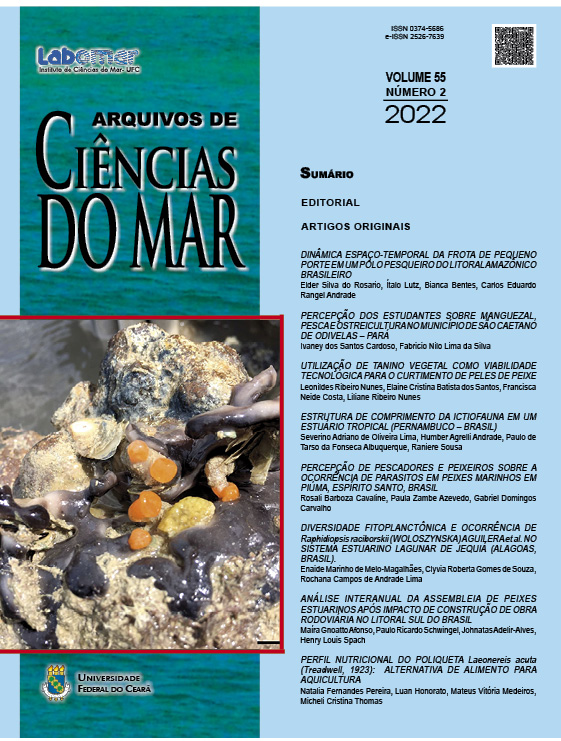ANÁLISE INTERANUAL DA ASSEMBLEIA DE PEIXES ESTUARINOS APÓS IMPACTO DE CONSTRUÇÃO DE OBRA RODOVIÁRIA NO LITORAL SUL DO BRASIL
DOI:
https://doi.org/10.32360/acmar.v55i2.60505Resumo
Ecossistemas de águas transicionais vêm sofrendo com destruição e perda de biodiversidade devido a diversos impactos antropogênicos. Assembleias de peixes estuarinos foram descritas em métricas taxonômicas e funcionais e as variações temporais foram investigadas ao longo do tempo, durante e depois de uma dragagem e construção de um aterro na enseada do Saco dos Limões, litoral Sul do Brasil. Os peixes foram coletados por meio de arrasto de fundo. Na análise temporal sobre a ictiofauna, foram utilizadas ordenação multidimensional e análise de similaridade baseada na presença e ausência de espécies, famílias e abundância de espécies e guildas. Foram identificadas 78 espécies, distribuídas em 33 famílias. A espécie mais abundante foi Genidens genidens (25,9%) e Sciaenidae, com 16,7% do total das espécies identificadas, foi a família com maior riqueza (13 spp.). Espécies marinhas visitantes foram a guilda de uso do estuário mais representativa (44,1%) e zoobentívoros foram a guilda alimentar com maior número de espécies (61,5%). Métricas taxonômicas evidenciaram mudanças interanuais nas assembleias de peixes, o que pode
estar relacionado às atividades de dragagem e ao aterro para a construção da rodovia na margem da enseada do Saco dos Limões. Métricas taxonômicas e funcionais podem ser empregadas com eficiência em trabalhos de monitoramento ambiental.
Palavras-chave: ictiofauna, águas transicionais, guildas, diversidade taxonômica e funcional.
Downloads
Downloads
Publicado
Como Citar
Edição
Seção
Licença
1. Proposta de Política para Periódicos de Acesso Livre
Autores que publicam nesta revista concordam com os seguintes termos:
- Autores mantém os direitos autorais e concedem à revista o direito de primeira publicação, com o trabalho simultaneamente licenciado sob a Licença Creative Commons Attribution que permite o compartilhamento do trabalho com reconhecimento da autoria e publicação inicial nesta revista.
- Autores têm autorização para assumir contratos adicionais separadamente, para distribuição não-exclusiva da versão do trabalho publicada nesta revista (ex.: publicar em repositório institucional ou como capítulo de livro), com reconhecimento de autoria e publicação inicial nesta revista.
- Autores têm permissão e são estimulados a publicar e distribuir seu trabalho online (ex.: em repositórios institucionais ou na sua página pessoal) a qualquer ponto antes ou durante o processo editorial, já que isso pode gerar alterações produtivas, bem como aumentar o impacto e a citação do trabalho publicado (Veja O Efeito do Acesso Livre).

